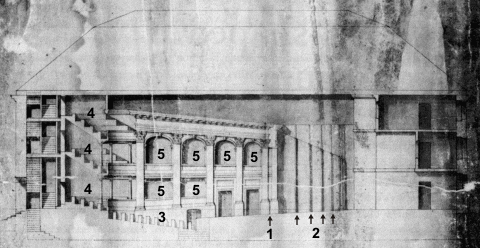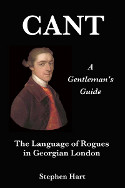18th Century Theatres
Drury Lane Theatre Royal
The Theatre Royal was located in a small block bounded by Drury Lane (east), Bridges Street (west), Great Russell Street (north) and Little Russell Street (south). There has been a theatre on this spot since 1663 although there have been four different buildings. The first burned down in 1672. The second, designed by Christopher Wren, opened its doors in 1674 and operated until 1791 when it was demolished. In 1794 the new theatre started operation but was burned down in 1809. The 1812 version has continued until the present day and is still an active theatre.
At the end of October, 1724, Pascal visited the theatre where Rose and John Gay were watching a revival of Colley Cibber's comedy, The Refusal. The revival was not a success and came to an abrupt end due to a riot in the theatre. Gay and Rose were sitting in the lower front box (see image below).
The Theatre Building

A longitudinal section by Christopher Wren, believed to be the Theatre Royal in Drury Lane.
- Proscenium arch
- Four pairs of shutters across the stage
- Pit
- Galleries
- Boxes
The theatre had no street front until 1775 when a facade was added on Bridges Street. Before that you had to enter the theatre down narrow passages beneath overhanging buildings into one of the three lobbies - one each for the Boxes, the Galleries and the Pit.
The Frenchman Henri Misson described the theatre in 1698:
The Pit is an Amphitheatre, fill'd with Benches without Backboards, and adorn'd and cover'd with green Cloth. Men of Quality, particularly the younger Sort, some Ladies of Reputation and Virtue, and abundance of Damsels that haunt for Prey, sit all together in this Place, Higgledy-piggledy, chatter, toy, play, hear, hear not.Farther up, against the Wall, under the first Gallery and just opposite to the Stage, rises another Amphitheatre, which is taken by persons of the best Quality, among whom are generally very few Men. The Galleries, whereof there are only two Rows, are fill'd with none but ordinary People, particularly the Upper one.
Ticket Prices
| Box | 5s |
| Pit | 3s |
| Lower Gallery | 2s |
| Upper Gallery | 1s |
The prices defined where the different social classes sat. The boxes were only for the nobility and the rich. The pit for critics, scholars and some members of the nobility. Tradesmen sat in the Lower Gallery with the Upper Gallery reserved for servants and other persons of no significance.
Lincoln's Inn Fields Theatre
The theatre was located in Portugal Row, to the south of the Fields. Originally it was Lisle's Tennis Court where Royal/Real Tennis was played. In 1662 it was converted to a theatre by the Duke's Company but reverted to being a tennis court in 1671 when the Company moved to the new Dorset Gardens Theatre.
It was converted back to a theatre in 1695 then replaced by a new building in 1714 by the theatre impresario (not called such because the term did not come into use until the 1740's) Christopher Rich. It was Christopher's son, actor/manager John, who staged The Beggar's Opera, based on the life of Jonathan Wild, in 1727.
The theatre was eventually abandoned in 1732 when Rich's company moved to the new Covent Garden Theatre.

